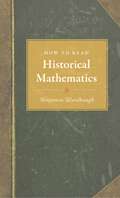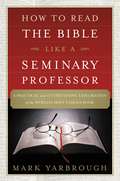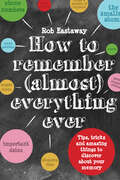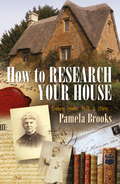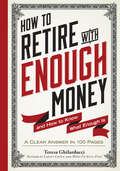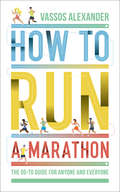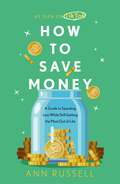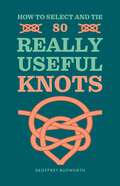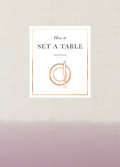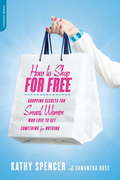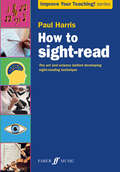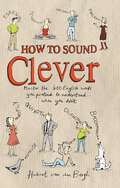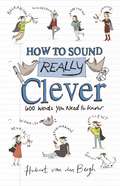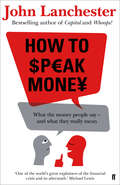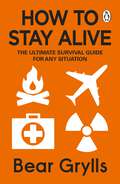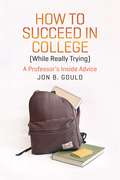- Table View
- List View
How to Read Historical Mathematics
by Benjamin WardhaughWritings by early mathematicians feature language and notations that are quite different from what we're familiar with today. Sourcebooks on the history of mathematics provide some guidance, but what has been lacking is a guide tailored to the needs of readers approaching these writings for the first time. How to Read Historical Mathematics fills this gap by introducing readers to the analytical questions historians ask when deciphering historical texts. Sampling actual writings from the history of mathematics, Benjamin Wardhaugh reveals the questions that will unlock the meaning and significance of a given text--Who wrote it, why, and for whom? What was its author's intended meaning? How did it reach its present form? Is it original or a translation? Why is it important today? Wardhaugh teaches readers to think about what the original text might have looked like, to consider where and when it was written, and to formulate questions of their own. Readers pick up new skills with each chapter, and gain the confidence and analytical sophistication needed to tackle virtually any text in the history of mathematics. Introduces readers to the methods of textual analysis used by historians Uses actual source material as examples Features boxed summaries, discussion questions, and suggestions for further reading Supplements all major sourcebooks in mathematics history Designed for easy reference Ideal for students and teachers
How to Read Historical Mathematics
by Benjamin WardhaughTechniques for deciphering texts by early mathematiciansWritings by early mathematicians feature language and notations that are quite different from what we're familiar with today. Sourcebooks on the history of mathematics provide some guidance, but what has been lacking is a guide tailored to the needs of readers approaching these writings for the first time. How to Read Historical Mathematics fills this gap by introducing readers to the analytical questions historians ask when deciphering historical texts.Sampling actual writings from the history of mathematics, Benjamin Wardhaugh reveals the questions that will unlock the meaning and significance of a given text—Who wrote it, why, and for whom? What was its author's intended meaning? How did it reach its present form? Is it original or a translation? Why is it important today? Wardhaugh teaches readers to think about what the original text might have looked like, to consider where and when it was written, and to formulate questions of their own. Readers pick up new skills with each chapter, and gain the confidence and analytical sophistication needed to tackle virtually any text in the history of mathematics.Introduces readers to the methods of textual analysis used by historiansUses actual source material as examplesFeatures boxed summaries, discussion questions, and suggestions for further readingSupplements all major sourcebooks in mathematics historyDesigned for easy referenceIdeal for students and teachers
How to Read Historical Mathematics
by Benjamin WardhaughTechniques for deciphering texts by early mathematiciansWritings by early mathematicians feature language and notations that are quite different from what we're familiar with today. Sourcebooks on the history of mathematics provide some guidance, but what has been lacking is a guide tailored to the needs of readers approaching these writings for the first time. How to Read Historical Mathematics fills this gap by introducing readers to the analytical questions historians ask when deciphering historical texts.Sampling actual writings from the history of mathematics, Benjamin Wardhaugh reveals the questions that will unlock the meaning and significance of a given text—Who wrote it, why, and for whom? What was its author's intended meaning? How did it reach its present form? Is it original or a translation? Why is it important today? Wardhaugh teaches readers to think about what the original text might have looked like, to consider where and when it was written, and to formulate questions of their own. Readers pick up new skills with each chapter, and gain the confidence and analytical sophistication needed to tackle virtually any text in the history of mathematics.Introduces readers to the methods of textual analysis used by historiansUses actual source material as examplesFeatures boxed summaries, discussion questions, and suggestions for further readingSupplements all major sourcebooks in mathematics historyDesigned for easy referenceIdeal for students and teachers
How to Read the Bible Like a Seminary Professor: A Practical and Entertaining Exploration of the World's Most Famous Book
by Mark YarbroughMany people admire and even revere the Bible, but they simply do not understand what they read, much less how to study Scripture. Yet they wish they could. In this insightful and alternately amusing guide, Professor Mark Yarbrough shows how easy and gratifying it is to unlock the hidden truths of God's Word and to discover a world where reading the Bible doesn't just satisfy our curiosity, but changes our life. To do this, the reader will step into the seminary classroom and observe the practical principles-the tricks of the trade-for becoming a more effective student of the Bible. But Yarbrough has made sure that his writing style and general approach will be appealing to both academic students and those involved in lay-level Bible study. Real life is whacky and in-your-face. Studying Scripture should be too.
How to Remember (Almost) Everything, Ever!
by Rob EastawayStruggling to remember all that information they're stuffing you with at school? Want to impress your friends with amazing memory feats? Can't keep on top of all your online passwords? Then you need this book! Packed with cool tricks and fun exercises, How To Remember Almost Everything, Ever will help you hone your memory to super-hero standards. Learn how imagining a walk down your street can help you remember a shopping list, how you can memorise a phone number by picturing the digits as letters, and how music, rhymes and even smells can help. Find out what your brain has in common with a computer, how spies committed things to memory, and how to flummox your parents with memory tricks. How to Remember Almost Everything, Ever is the perfect book for anyone who wants to improve their study skills and make their memory the best it can be.
How To Research Your House: Every Home Tells a Story...
by Ms Pamela BrooksDo you want to know more about the history of your house, find out about the lives of former inhabitants, and discover more about the local community in which your house stands? Pamela Brooks, author of "How to Research Local History" will help you get started. She'll take you step by step along a fascinating trail of discovery, starting with the building itself and progressing to who lived there.Contents: 1. Introduction; 2. Preparing to research; 3. Secondary sources; 4. The Architecture of Your House - External Features; 5. The Architecture of Your House - Internal Features; 6. The building itself: Maps, Photographs and Sketches; 7. The Building Itself: Other Documents; 8. Who Lived There? Deeds and Taxation Records; 9. Who lived there? Personal Records; 10. Other sources; Appendices; Index.
How to restore Classic Car Bodywork: New Updated & Revised Edition
by Martin ThaddeusNow in updated, revised and enlarged format, an invaluable guide for the home restorer. Coverage includes: tools; panel removal/fitting; sectional repairs; sills, floors and outriggers; chassis members; multiple panel assemblies; welding; metal forming techniques (expanded coverage in this edition); tricks of the trade, and much, much more.
How to restore Honda CX500 & CX650: YOUR step-by-step colour illustrated guide to complete restoration (Enthusiast's Restoration Manual)
by Ricky BurnsWhen Honda released the CX500, the sales brochure stated 'First into the Future,' and described the bike as a road sports V-twin. Honda's first venture into the V-twin engine market, with water cooling and shaft drive, was certainly different from their previous twin- and four-cylinder models. Known for its good handling and fuel economy, the low maintenance Honda was comfortable, loved by tourers and couriers alike and, after overcoming early teething troubles, developed a reputation for reliability. Sportier models incorporating turbochargers were also released, for those looking for an additional adrenaline rush. After thirty years, there's now a resurgence of interest in the CX models, both from restorers and custom builders, with aftermarket cafe racer kits available, too.The techniques, tips and tricks used by an experienced restorer will save you time and money. You'll see that you don't need expert knowledge or a fully fitted workshop for a restoration project. Packed full with photographs and detailed instructions, this book is your perfect guide, from start to finish.
How to restore Honda SOHC Fours: YOUR step-by-step colour illustrated guide to complete restoration (Enthusiast's Restoration Manual)
by Ricky BurnsIn 1969 Honda launched a motorcycle that many consider to be the world's first superbike. The Honda CB750 had the first mass-produced 4-cylinder inline engine, a single overhead camshaft with four carburettors, a 4-into-4 exhaust system, and came with electric start and front disc brakes as standard. This specification set the bar higher than ever before on a production motorcycle, and led to other Japanese manufacturers introducing their own 4-cylinder models.Following the success of the original CB750, Honda went on to produce a range of motorcycles using SOHC 4-cylinder engines. All with their own characteristics, they proved to be reliable and smooth running, and even today, with the correct care, can offer reliable transport on modern roads.Now, with some examples over 40 years old, many enthusiasts wish to restore these classic machines. This book will guide the enthusiast through a full restoration of these fine classic motorcycles.
How to restore Volkswagen Bus: Enthusiast's Restoration Manual (Enthusiast's Restoration Manual)
by Mark PaxtonThe only book currently available that comprehensively deals with the realities of restoring a VW Bay Window Bus. With over 1500 mainly colour photos, it guides the reader clearly through body and chassis repairs, paint work, interior re-trimming and most common mechanical problems. The skills, techniques and even the tools needed to complete these tasks are explained in jargon free language, to ensure that even those enthusiasts with no previous restoration experience will feel confident in sorting out their Bus. An indispensable and unique guide for lovers of these fast appreciating classics.
How to Retire with Enough Money: And How to Know What Enough Is
by Teresa GhilarducciHow to Retire with Enough Money is a single-sit read than can change the course of your retirement by cutting through the confusion, misinformation, and bad policy-making that keeps us spending or saving poorly.
How to Run a Marathon: The Go-to Guide For Anyone And Everyone
by Vassos AlexanderEver been tempted to try a marathon? Maybe you’ve just started running, perhaps you’re gaining confidence, or are you already well on your way to conquering the iconic distance? Whatever stage you’re at on your journey, join marathon man Vassos Alexander as he shows us why we shouldn’t be afraid of the big 26.2.
How To Save Money: A Guide to Spending Less While Still Getting the Most Out of Life
by Ann RussellWith the recent cost of living crisis, we are all looking for ways to cut bills and save money. Ann Russell, who is best known as "TikTok's Auntie", has lived much of her life on a tight budget, and since energy bills first started rising, has been answering fan's questions not just about cleaning but about all kinds of ways to economise. Following on from her first book, How To Clean Everything, in How To Save Money Ann will share her advice on the best ways to save money and cut back in all sorts of areas, covering everything from budgeting to meal planning and reducing food waste, and from tips on spending less each month to the most energy efficient ways to heat your house, do your laundry etc. Written with Ann's trademark warmth, humour and understanding, this is a book that will help everyone who is looking to spend less while still getting the most out of life.
How to Select and Tie 80 Really Useful Knots
by Geoffrey BudworthKnowing how to tie knots can help you in everything from work around the home, camping and fishing trips, and even art and craft projects. This is a comprehensive guide to 80 of the most useful knots for:- Sailing- Camping- Climbing and abseiling- Home and garden- Fishing and outdoor pursuitsHow to Select and Tie 80 Really Useful Knots contains an explanation of the basic terms used relating to knots and ropes, and cordage. From the rolling hitch to the boa knot, every knot is accompanied by clear step-by-step instructions and illustrations, making this a resource you'll turn to time and time again.As well as a comprehensive glossary that explains many common terms, there's an introduction to knots and ropes, cordage, and a potted history of each of the knots.
How to Set a Table: Inspiration, ideas and etiquette for hosting friends and family (How To Ser.)
by Clarkson PotterThis beautiful guide includes creative ways to style a table - for dinner, a cocktail party, brunch, picnic in the park, and other fun occasions.Whatever the size of your home or budget, How to Set a Table features stylish, modern ideas for welcoming friends and family in your home. This pretty gift book serves as a practical step-by-step guide to entertaining - with information on etiquette, place setting basics, centerpieces, mixing and matching, essential glassware, napkin folds, and unexpected ideas for using the great tableware you can find at flea markets. How to Set a Table updates a classic topic for a new generation of hosts.
How to Shop for Free: Shopping Secrets for Smart Women Who Love to Get Something for Nothing
by Kathy SpencerKathy Spencer can whittle a 267.22 grocery bill down to one penny. How to Shop for Free is Spencer's smart, sassy, step-by-step savings guide that teaches you how to do just that-and more. You'll learn how to find the best savings and combine them with store promotions, rewards programs, and store credit to get almost anything for free-from organic produce to makeup, prescription drugs to clothing. With an eye toward cutting your monthly spending on the basics, Spencer guides you through many popular stores-including CVS, Kohl's, Safeway, Target, and Walgreens-and explains how to maximize your savings. Follow Spencer's plan and, by the end of the book, you'll be shopping for free.
How to Shop for Free: Shopping Secrets for Smart Women Who Love to Get Something for Nothing
by Kathy SpencerKathy Spencer can whittle a 267.22 grocery bill down to one penny. How to Shop for Free is Spencer's smart, sassy, step-by-step savings guide that teaches you how to do just that -- and more. You'll learn how to find the best savings and combine them with store promotions, rewards programs, and store credit to get almost anything for free -- from organic produce to makeup, prescription drugs to clothing. With an eye toward cutting your monthly spending on the basics, Spencer guides you through many popular stores -- including CVS, Kohl's, Safeway, Target, and Walgreens -- and explains how to maximize your savings. Follow Spencer's plan and, by the end of the book, you'll be shopping for free.
How to sight-read (Improve your teaching)
by Paul HarrisThe full eBook version of How to sight-read in fixed-layout format. Do you believe that some people can sight-read and others can't? In How to sight-read, Paul Harris dispels this and other common misconceptions about sight-reading, presenting instead the idea of sight-reading as a technique that can be developed and learned by anyone. He breaks down the fascinating science behind sight-reading as well as providing practical advice and exercises that can be incorporated into both lessons and practice. The engaging activities in the book are supported by a unique accompanying web app enabling readers to improve key areas of sight-reading technique including rhythm, pattern recognition, and brain processing speed. Written to help students, parents and teachers alike, How to sight-read challenges existing perspectives on sight-reading and presents an innovative new approach to teaching and learning this vital musical skill. 'This book has elevated sight-reading practice to the next level, using a fresh, fun approach that blends solid vision, science principles, and 21st-century technology.' Debra Grant BSc (Hons) MCOptom 'Paul Harris has offered the concept that sight-reading is simply a technique that can be easily learnt by us all... This is a mustread for music students and teachers.' John Hutchins, Director Junior Academy and LRAM, Royal Academy of Music
How to Sound Clever: Master the 600 English words you pretend to understand...when you don't
by Hubert van den BerghHow to Sound Clever explains the etymology of 600 key words you really ought to know, but haven't had the time to look up in the dictionary. Each entry features an etymological description as well as useful example phrases so that readers can quickly see the correct context for each word. Anecdotes and witty illustrations appear throughout to make a book that is entertaining and will help the reader to boost their vocabulary. An ideal gift and a useful book for everyone have to hand when they come across a word you should know, but don't.Colin Dexter has described How to Sound Clever thus: 'This admirable book is a wholly welcome antidote to the semi-demi-literacy of the 21st century. Go out and buy it!'
How to Sound Really Clever: 600 Words You Need to Know
by Hubert van den Bergh Sandra HowgateHow to Sound Really Clever explains and illustrates over 600 words that can outfox us, such as 'condign', 'Zelig-like' and 'agitprop'. This is the sequel to the successful How to Sound Clever (2010) which taught you 600 words you really ought to know but haven't had the time to look up in the dictionary.Each entry features an etymological description as well as useful example phrases so that readers can quickly see the correct context for each word. Anecdotes and witty illustrations appear throughout to make this an entertaining book that will help readers to boost their vocabulary.
How to Sound Really Clever: 600 Words You Need to Know
by Hubert van den Bergh Sandra HowgateHow to Sound Really Clever explains and illustrates over 600 words that can outfox us, such as 'condign', 'Zelig-like' and 'agitprop'. This is the sequel to the successful How to Sound Clever (2010) which taught you 600 words you really ought to know but haven't had the time to look up in the dictionary.Each entry features an etymological description as well as useful example phrases so that readers can quickly see the correct context for each word. Anecdotes and witty illustrations appear throughout to make this an entertaining book that will help readers to boost their vocabulary.
How to Speak Money: What The Money People Say--and What It Really Means
by John LanchesterMoney is our global language. Yet so few of us can speak it. The language of the economic elite can be complex, jargon-filled and completely baffling. Above all, the language of money is the language of power - power in the hands of the same economic elite.Now John Lanchester, bestselling author of Capital and Whoops! sets out to decode the world of finance for all of us, explaining everything from high-frequency trading and the World Bank to the difference between bullshit and nonsense.As funny as it is devastating, How To Speak Money is a primer and a polemic. It's a reference book you'll find yourself reading in one sitting. And it gives you everything you need to demystify the world of high finance - the world that dominates how we all live now.
How to Stay Alive: The Ultimate Survival Guide for Any Situation
by Bear GryllsThe ultimate survival guide from the world’s leading survival expert. Nobody knows survival like Bear Grylls. There is a barely a terrain he hasn’t conquered or an extreme environment he hasn’t experienced. Over the years — from his time in 21 SAS, through to his extraordinary expeditions climbing (and paragliding over) Everest, travelling through the Arctic's treacherous Northwest Passage, crossing the world’s oceans and taking part in adventures to the toughest corners of each of the seven continents — Bear has accumulated an astonishing wealth of survival knowledge.Now, for the first time, he is putting all his expertise into one book. How To Stay Alive will teach you:- How to survive a bear attack- How to fly a plane in an emergency- How to make fire from virtually nothing - How to drive off-road- How to navigate using the stars- How to administer first-aid- How to escape a burning building- How to survive the most extreme conditionsAnd dozens of other essential skills to survive the modern world.
How to Succeed in College: A Professor's Inside Advice (Chicago Guides to Academic Life)
by Jon B. GouldAfter years of preparation and anticipation, many students arrive at college without any real knowledge of the ins and outs of college life. They’ve been focused on finding the right school and have been carefully guided through the nuances of the admissions process, but too often they have little knowledge about how college will be different from high school or what will be expected of them during that crucial first year and beyond. Written by an award-winning teacher, How to Succeed in College (While Really Trying) provides much-needed help to students, offering practical tips and specific study strategies that will equip them to excel in their new environment. Drawing on years of experience teaching at a variety of campuses, from large research universities to small liberal arts colleges, Jon B. Gould gives readers the lay of the land and demystifies the college experience. In the course of the book, students will learn how to identify the best instructors, how to choose classes and settle on a major, how to develop effective strategies for reading and note taking, and how to write good papers and successfully complete exams. Because much of the college experience takes place outside of the classroom, Gould also advises students on how to effectively manage their cocurricular activities, work obligations, and free time, as well as how to take advantage of the typically untapped resources on every campus. With candid advice and insights from a seasoned insider, this guide will leave students better prepared not only to succeed in college but to enjoy it as well.
How to Succeed in College: A Professor's Inside Advice (Chicago Guides to Academic Life)
by Jon B. GouldAfter years of preparation and anticipation, many students arrive at college without any real knowledge of the ins and outs of college life. They’ve been focused on finding the right school and have been carefully guided through the nuances of the admissions process, but too often they have little knowledge about how college will be different from high school or what will be expected of them during that crucial first year and beyond. Written by an award-winning teacher, How to Succeed in College (While Really Trying) provides much-needed help to students, offering practical tips and specific study strategies that will equip them to excel in their new environment. Drawing on years of experience teaching at a variety of campuses, from large research universities to small liberal arts colleges, Jon B. Gould gives readers the lay of the land and demystifies the college experience. In the course of the book, students will learn how to identify the best instructors, how to choose classes and settle on a major, how to develop effective strategies for reading and note taking, and how to write good papers and successfully complete exams. Because much of the college experience takes place outside of the classroom, Gould also advises students on how to effectively manage their cocurricular activities, work obligations, and free time, as well as how to take advantage of the typically untapped resources on every campus. With candid advice and insights from a seasoned insider, this guide will leave students better prepared not only to succeed in college but to enjoy it as well.
